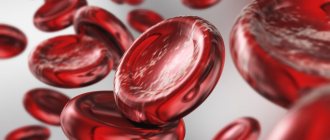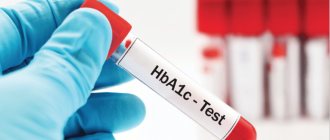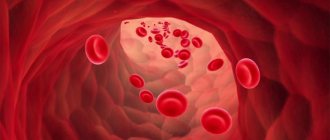The functioning of all internal organs and systems, as well as how energetic and cheerful a person will be, largely depends on the level of hemoglobin. Therefore, a decrease in this indicator is a signal to action. After all, low hemoglobin not only leads to constant fatigue, problems with skin, nails and hair, but can also cause severe complications, especially for pregnant women and children.
What is hemoglobin and its role in the body
Hemoglobin is a complex protein belonging to the heme-containing chromoproteins and present in erythrocytes (red blood cells shaped like a biconcave disc). In the body, it performs an important function: it is responsible for the transfer of oxygen from the lungs to the tissues and the transport of carbon dioxide from the tissues to the lungs. Thus, it plays a huge role in ensuring gas exchange of all cells and therefore a decrease in its amount in the blood negatively affects the functioning of the entire body and individual organs. But hemoglobin is also involved in maintaining the acid-base balance, redox reactions, and DNA synthesis.
Hemoglobin is formed in young red blood cells as a result of the penetration of iron atoms into them. They enter the body not only from the outside, but are also formed as a result of the destruction of already existing hemoglobin in red blood cells, completing their life cycle. The lifespan of an erythrocyte is 120 days. And the process of their decay occurs in the spleen.
Each red blood cell contains 400 million hemoglobin molecules. It is this that gives them and the blood in general a red color.
Each hemoglobin molecule consists of 96% of the simple protein globin and 4% of the non-protein group - heme. Globin is an albumin protein with a quaternary structure. Heme is a complex whose central unit is the divalent iron atom. It is due to its presence, as well as the influence of globin, that heme is able to attach oxygen and transport it with the bloodstream throughout the body, and then give it to the cells, “taking away” carbon dioxide molecules.
In addition to oxygen, heme can attach carbon monoxide molecules, an additional iron ion and some other compounds, losing the ability to perform its functions.
In the body, namely in the lungs, liver, spleen, and intestinal mucosa, iron reserves are formed in the form of ferritin and hemosiderin. They are activated when there is insufficient supply of iron from the outside to synthesize hemoglobin in sufficient quantities. Therefore, a decrease in hemoglobin levels indicates the depletion of these reserves, which means a long-term problem of low amounts of iron supplied from food, or the occurrence of disturbances in its absorption in the intestines and transport by special enzymes (transferrin) throughout the body.
Kinds
From the moment the fetus is conceived, hemoglobin is already present in its blood - this is the so-called fetal hemoglobin HbP. In this form, it exists from approximately 5 to 18 weeks, and after the formation of the fetal liver, it is transformed into fetal hemoglobin HbF. It remains in this form even after the birth of the child up to 4-6 months. Moreover, as the baby grows older, its amount decreases, and in return the content of hemoglobin HbA, characteristic of adults, increases. It is this type of it that is the main one and is subject to research.
At the same time, there are several forms of hemoglobin that are constantly present in the blood in larger or smaller quantities. The level of each of them is an important diagnostic criterion. There are:
- Oxyhemoglobin is “normal” hemoglobin, which contains ferrous iron. It is responsible for transporting oxygen to tissues and organs.
- Carbohemoglobin is “normal” hemoglobin bound to carbon dioxide molecules.
- Methemoglobin is a compound formed by the oxidation of oxyhemoglobin, resulting in the formation of 3-valent iron. Therefore, it is not able to interact with oxygen and act as its carrier. But it forms strong bonds with hydrocyanic acid, hydrogen fluoride and a number of other toxic substances, which has found application in medical practice.
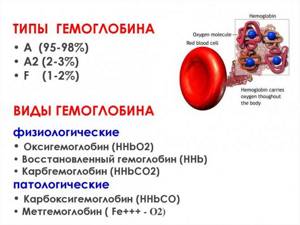
Myoglobin is classified as a separate type. It is also an iron-containing protein characteristic of muscle tissue. It functions as an oxygen depot in it and is used during physical activity to ensure a complete supply of oxygen to muscle cells.
Glycated hemoglobin (HbA1c) is isolated separately. This is hemoglobin bound to glucose. Its indicators are important in diagnosing and monitoring the effectiveness of treatment for diabetes mellitus types 1 and 2, as it helps to most accurately estimate the average level of sugar remaining in the blood for 2-4 months. Accordingly, the higher the HbA1c value, the more glucose was present in the blood in recent months.
Norms and types of anemia
The hemoglobin content in the blood is influenced by many factors, very different in nature. Moreover, its indicators directly depend on age and gender. Therefore, people of different age groups have their own standards for hemoglobin levels:
- for women – 120–155 g/l;
- for pregnant women – more than 110 g/l;
- for men – 130-160 g/l;
- glycated hemoglobin HbA1c – 5.7% (for patients with diabetes mellitus, an HbA1c level of less than 7% is considered a good indicator).
In infants, hemoglobin levels are the highest and decrease as they grow older. By the age of 18, they reach generally accepted norms for women and men.
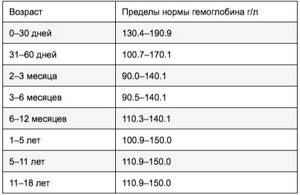
But hemoglobin levels depend on a large number of different indicators, including:
- age;
- features of the constitution;
- level of physical activity;
- nutritional features;
- environmental conditions;
- tendency to smoke.
Therefore, the concentration of hemoglobin in the blood is a relative value. Moreover, it depends not only on the content of hemoglobin itself, but also on the volume of blood plasma. Therefore, for some people, low hemoglobin is an individual feature and does not require adjustment.
A decrease in its level is indicated when the indicators obtained during a general blood test deviate from normal values. In this case, the color indicator, the average hemoglobin content in 1 red blood cell, and its average cellular concentration in relation to hematocrit are also taken into account. Only with a comprehensive assessment of the results of a blood test can we talk about a decrease in hemoglobin levels. This is called anemia. And it, in turn, can accompany a large number of different diseases. At the same time, anemia of varying severity is distinguished depending on how low the hemoglobin content is:
- light – 90-110 g/l;
- moderate severity – 70-90 g/l;
- heavy – less than 70 g/l.
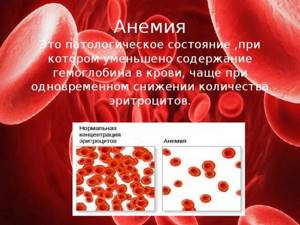
Hemoglobin measurement with portable rapid tests
To measure hemoglobin levels at home, you can use simple and convenient test strips. Many manufacturers offer functional portable blood analyzers that measure not only iron protein levels, but also blood sugar and cholesterol. To do this you need to follow a few simple steps:
- wash your hands thoroughly;
- sit down and try to relax;

- Shake your hand for 2-3 seconds to activate blood circulation in your hand;
- lubricate your finger with alcohol;
- install the test strip with a connector specially designated for it - the device turns on in automatic mode;
- The device comes with a special pen with a needle, with which you need to puncture the treated finger;
- Apply a drop of blood from your finger to the control field of the strip.
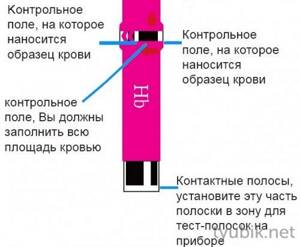
Within a few seconds, information about the level of hemoglobin in the blood will appear on the device monitor. Many such devices are equipped with an electronic memory function, which allows them to record the obtained analysis result.
Causes
Hemoglobin levels are influenced by many different factors. Basically, its decrease is typical for situations in which there is a decrease in the number of red blood cells or the occurrence of iron deficiency, disturbances in its absorption and transportation. This is observed when:
- bone marrow pathologies, including leukemia, aplastic anemia, lymphoma;
- renal failure, since when the quality of kidney function decreases, the synthesis of erythropoietin, which is necessary to activate the synthesis of red blood cells, is disrupted;
- uterine fibroids, since they often cause heavy intermenstrual bleeding;
- endometriosis;
- abnormally heavy, prolonged menstrual bleeding;
- hemorrhoids;
- hidden bleeding, in particular characteristic of gastric and duodenal ulcers, erosive esophagitis, ulcerative colitis, chronic pyelonephritis, urolithiasis and a number of other diseases;
- autoimmune, some infectious diseases leading to a shortening of the life of red blood cells and/or disruption of iron transport by the transferrin protein, including tuberculosis;
- systemic vasculitis, systemic lupus erythematosus;
- sickle cell anemia - a hereditary pathology in which red blood cells are shaped like a sickle rather than a biconvex disc;
- thalassemia is a hereditary disease in which the process of globin formation is impaired to varying degrees;
- oncological diseases;
- allergic diseases;
- helminthic infestation;
- liver diseases, especially cirrhosis, hepatitis;
- celiac disease;
- hypothyroidism;
- cystic fibrosis;
- hereditary spherocytosis;
- lack of the G6PD enzyme, etc.
Therefore, it is important to have a blood test regularly, at least once a year. This will allow us to detect pathological changes in the body at the earliest stages, perhaps even in the absence of any symptoms, and begin treatment.
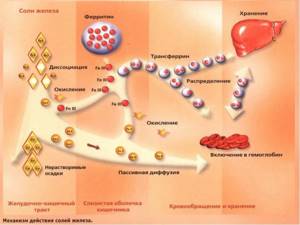
What is hemoglobin?
Hemoglobin
- a substance found in human blood. The analysis is carried out not only for it, but also for iron compounds that are its carriers. This allows you to quickly determine accurate data in adults in order to select the optimal way to restore normal values.
Hemoglobin levels are checked even during a general blood test.
With diabetes and a number of other diseases, a low rate is always observed. This forces you to “drink” iron or take other medications. It is better to understand how to deal with the problem, and even better to anticipate it so as not to have to deal with a visit to the clinic.

Consequences of decreased hemoglobin levels
Since the main function of hemoglobin is to ensure the respiration of all cells of the human body, its deficiency can lead to oxygen starvation or hypoxia. In addition, prolonged lack of hemoglobin provokes the development of:
- chronic fatigue syndrome;
- damage to the heart muscle with the development of myocardial dystrophy, and subsequently heart failure;
- decreased immunity, which increases the risk of acute respiratory infections, infectious diseases of various kinds, and exacerbation of existing chronic diseases;
- liver dysfunction;
- difficulties with conception and pregnancy due to deterioration of the reproductive system and menstrual irregularities;
- disorders of the nervous system with increased irritability, tearfulness, decreased memory, attention, etc.
Mostly, complications develop when stable low hemoglobin persists for more than 5 years.
One of the most severe consequences that can result from long-term low hemoglobin is hypoxic coma. This is accompanied by severe paleness of the skin, convulsions, and loss of consciousness. This is rare, but still not impossible. But hypoxia in any case has an extremely negative effect on the condition of the whole organism and greatly complicates the course of such chronic diseases as coronary artery disease and bronchial asthma. It can also cause myocardial infarction and stroke. Therefore, it is important to promptly diagnose not only a decrease in hemoglobin, but also the reasons for the decrease in its level in the blood and take measures appropriate to the situation.

It is very important to regularly monitor hemoglobin levels during pregnancy, since a lack of it can lead to complications during pregnancy, as well as disturbances in fetal development. Thus, with low hemoglobin, the likelihood of premature birth, decreased contractility of the uterus, delayed fetal growth and intellectual development, and disturbances in the functioning of the nervous and respiratory systems increases sharply.
A persistent decrease in hemoglobin levels is especially dangerous for children, as this can provoke the occurrence of delayed intellectual development.
Determination of hemoglobin using the device
Today in the pharmacy chain you can find a wide selection of special devices designed to measure hemoglobin levels at home. Such a device is called a hemoglobinometer and is produced by several pharmacological companies.
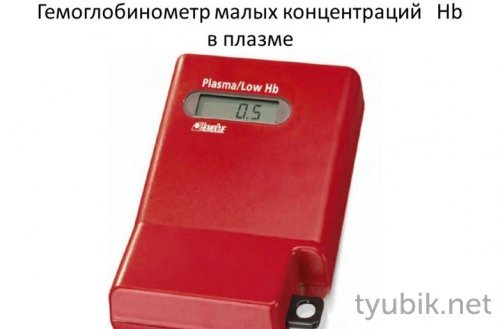
Some of the most popular devices are MiniGem 540 and Easy Touch. Such hemoglobinometers allow you to determine protein levels in 10 seconds. Technique for performing home analysis:
- using a special needle from the set, pierce your finger;
- drop a few drops of blood into a test tube;
- add hydrochloric acid (included with the device);
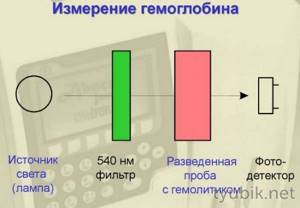
- pour distilled water into the device - the liquid should take on the scarlet hue of blood;
- evaluate the result obtained on a special scale and compare it with the presented age norms.
The results of the study will be reliable only if you properly prepare for the procedure yourself. To do this, you must avoid any food or drink for at least 12 hours, and also stop taking any medications.
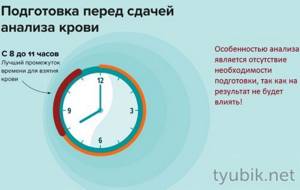
Signs of decreased hemoglobin
A decrease in the amount of hemoglobin in the blood may be indicated by:
- constant fatigue and apathy;
- frequent headaches, dizziness;
- sleep disorders of various types from insomnia to constant drowsiness;
- decreased appetite;
- increased excitability;
- depressive states;
- pale skin;
- long-lasting bruises and poorly healing wounds;
- increased heart rate;
- swelling of the limbs;
- decreased immunity, which is accompanied by an increased incidence of infectious diseases:
- noise in ears;
- shortness of breath during exercise;
- menstrual irregularities of varying severity;
- decreased potency in men.
In the vast majority of cases, low hemoglobin is a consequence of iron deficiency in the body. Therefore, in addition to asthenic syndrome (weakness, etc.), signs of iron deficiency anemia are often observed:
- changes in the condition of nails with an increase in their fragility, a decrease in thickness, the appearance of a tendency to delamination, spots of a different nature, depressions (onychodystrophy);
- the formation of cracks in the corners of the mouth, which are often popularly called jams;
- hair loss or slower growth;
- dry skin, peeling;
- a change in taste and smell with the development of a desire to eat frankly inedible objects, for example, chalk, earth, clay or raw foods (dough, meat), smell gasoline, acetone, exhaust gases, etc.;
- development of a seemingly causeless increase in body temperature to 37–37.5°.

In older people, a decrease in hemoglobin concentration in the blood is often accompanied primarily by shortness of breath, weakness and dizziness. This is often perceived as inevitable age-related changes and ignored. At the same time, older people are more prone to developing anemia and its negative consequences, so in no case should symptoms that arise be ignored.
When to take a blood test and see a doctor
The reason for conducting a blood test for hemoglobin level and obtaining advice from a therapist, pediatrician (for children) or hematologist should be:
- the appearance of one or more of the above symptoms;
- the presence of people with blood diseases among close relatives;
- serious deterioration in health during and after an infectious disease;
- adherence to a strict diet that causes iron deficiency;
- heavy blood loss as a result of injury or surgery;
- confirmation of pregnancy;
- diagnosing a disease that can lead to a decrease in hemoglobin levels.
In addition, it is mandatory to take a complete blood test (CBC) 1-2 times a year for preventive purposes.
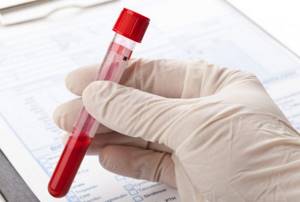
Symptoms of low hemoglobin
Folk remedies often help to quickly increase hemoglobin. It’s just difficult for people to figure out what symptoms a child should have to use them:
- general weakness;
- constant drowsiness;
- difficult getting up in the morning;
- fatigue;
- noise in ears;
- persistent headaches;
- dizziness and fainting;
- menstrual irregularities;
- noticeable decrease in potency;
- loss of appetite.

A large list of symptoms shows that glycated hemoglobin is dangerous. High levels are less dangerous than low levels because red blood cells are responsible for carrying oxygen. This reason forces you to regularly take blood tests to be sure of your own normal condition.
The appearance of any symptom indicates potential danger. With poor performance, the body begins to suffer, and the immune system is weakened. As a result, side diseases begin to develop that can develop into a dangerous chronic form.
How to increase low hemoglobin: basic principles
You can talk about taking measures to increase hemoglobin levels only after consulting a doctor. Only a qualified specialist can take into account all the features of the patient’s condition and determine the need to prescribe any therapy, not to mention its nature.
Depending on the severity of the situation, to restore normal hemoglobin levels, the doctor may recommend adjusting the diet and using iron-containing drugs or dietary supplements. But they also make sure to take measures to eliminate the main cause of anemia. If it is impossible to immediately establish it (pregnancy, recent surgery, severe trauma, hemorrhoids), a comprehensive study is prescribed, which includes:
- CBC with leukocyte formula;
- biochemical blood test with the study of all indicators related to the level of iron in the body;
- stool test for occult blood;
- gynecological examination and ultrasound of the pelvic organs;
- OAM;
- fibrogastroduodenoscopy and colonoscopy (according to indications);
- Ultrasound of the abdominal organs, kidneys, thyroid gland, etc.
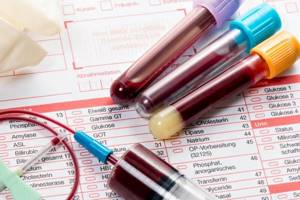
Based on the examination results, in most cases it is possible to establish the cause of the decrease in hemoglobin levels and select treatment that will be aimed at eliminating it. Only in this case, in combination with diet correction and/or taking iron-containing medications, will it be possible to cope with anemia, improve the patient’s condition and avoid the development of complications.
In case of severe anemia, patients may be prescribed a transfusion of red blood cells for health reasons.
Hemoglobin norm depending on age
The normal level of iron-containing protein depends on several factors. It differs radically depending on the age and gender of a person. Before determining the amount of iron-containing protein in the blood, you need to familiarize yourself with the generally accepted reference values for this indicator.
- middle-aged men - 120-160 g/l;
- middle-aged women - 110-140 g/l;
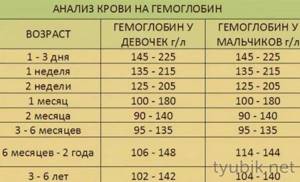
- children under 6 months - 140-220 g/l;
- children from 6 months to 18 years - 95-140 g/l.
A decrease in hemoglobin levels below critical levels is called iron deficiency anemia and requires treatment. Correction of healthy protein levels can be carried out using medications containing iron or following a special diet.
To verify the reduced value, it is advisable to repeat the home measurement several times.
If all the results indicate a pathologically low level of hemoglobin, you should definitely consult a physician, since anemia can have dangerous consequences for the human body.
If a patient shows signs of an infectious-inflammatory process, it is necessary to find out the cause in a timely manner in order to begin treatment. Laboratory and instrumental tests are carried out to identify the pathogen and the state of the body. Read more in the article: “how to find out if there is an infection in the body.”

Diet correction
If there are slight deviations in hemoglobin levels from the norm, you can try to improve blood counts by increasing foods high in iron and folic acid in your daily diet. These include:
- offal, especially liver and beef tongue;
- beef, white chicken;
- seafood, black and red caviar;
- broccoli, spinach, green beans, watercress, parsley;
- cabbage, pumpkin;
- legumes;
- tomatoes, new potatoes (with skin), beets;
- onion;
- apples, plums, pomegranates, pears, apricots, quinces, persimmons, peaches;
- black currants, strawberries, blueberries, cranberries;
- tofu;
- buckwheat, oatmeal.
It is important to ensure sufficient intake of folic acid into the body, which takes part in the synthesis of red blood cells. If it is deficient, they will not ripen, which will also provoke hemoglobin deficiency. Therefore, it is important to include in your daily diet:
- beef;
- spinach;
- green salad;
- avocado;
- rice;
- legumes;
- peanut.
Hematogen, which can be bought at the pharmacy, is an excellent source of iron and B vitamins necessary for its absorption. Therefore, to maintain optimal iron levels, it can be used for preventive purposes.
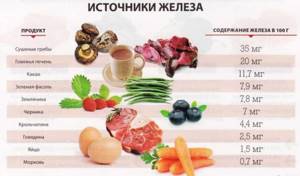
Thus, some foods act as both a source of iron and folic acid. Therefore, when creating a menu, special attention should be paid to veal or beef, spinach, and legumes.
But we must not forget about the digestibility of iron. So, it is absorbed as completely as possible from the intestines in the presence of ascorbic acid, i.e. vitamin C, as well as vitamin A. Therefore, it is worth adding butter or vegetable oil, as well as lemon juice, to salads. Other sources of vitamin A are fish and liver, and ascorbic acid is present in greater or lesser quantities in almost all vegetables and fruits. But there is especially a lot of it in bell peppers. Therefore, it should also be included in the daily menu.
You should not consume dairy and fermented milk products at the same time as meat and vegetable dishes. This is due to the fact that calcium and casein reduce the absorption of iron from the intestines. In addition, calcium is present in figs and soybeans. Therefore, they should also not be separated into a separate meal.
Phytic acid similarly impairs the absorption of iron. It is present in most types of nuts and sesame. Therefore, they should not be consumed shortly before eating meat or vegetable dishes, or in the near future after that.
Wheat and grains also bind iron, which impairs its absorption. Therefore, you should eat meat without bread and not with cereals or pasta, but with vegetables.
It can be difficult to create a menu on your own to compensate for iron deficiency. After all, you need to not only eat foods rich in it, but also combine them wisely with others. Therefore, if you don’t have the time and desire to understand the intricacies of iron absorption in the body, you should consult a nutritionist.
Iron supplements
Iron supplements are the basis for the treatment of anemia. On the modern pharmaceutical market there are a large number of drugs and biologically active additives (BAA) containing iron. They differ not only in iron content, but also in its form. In most cases, complex preparations are chosen that additionally contain vitamin C, B9, B12, which increase the absorption of iron.
All modern drugs for increasing hemoglobin can be divided into:
- Ionic iron-containing products, in which ferrous sulfate and fumarate are used as the active substance. These are Ferretab, Aktiferrin, Sorbifer Durules, etc.
- Nonionic, where the active ingredient is ferric iron. They are better tolerated and are less likely to cause side effects. These include Ferrum lek, Maltofer and some others.
- Preparations based on liposomal iron (pyrophosphate). They have no risk of side effects and ensure absorption of exactly the amount of iron that the body needs, which eliminates the possibility of an overdose.
The most popular iron supplements are:
- Sorbifer Durules;
- Maltofer;
- Aktiferrin;
- Ferrum lek;
- Ferretab;
- Totema;
- Nan-O-Fer.
In recent years, the Swiss dietary supplement Nan-O-Fer has proven itself very well on the market of iron-containing preparations. Its main advantages are the absence of side effects due to the presence of iron pyrophosphate, eliminating the possibility of excess iron (thanks, again, to the use of liposomal iron), increasing vitality and improving brain functions such as memory, attention and thinking. Also, the drug has an attractive price.

The recommended daily dose of iron depends on the gender, age, weight of the patient and individual characteristics. If we talk about average indicators, then:
- for men – 8 mg/day;
- for women – up to 18 mg/day;
- for pregnant women – up to 27 mg/day.
If the selected drug is well tolerated, it is initially taken at the maximum therapeutic dose. Subsequently, as hemoglobin levels increase, the dosage is gradually reduced to maintenance over several months. On average, the course of treatment lasts 1-5 months.
It is not recommended to start taking iron supplements on your own or exceed the recommended dose. This can cause the development of hemochromatosis, siderosis of internal organs, as well as dysfunction of the liver and gastrointestinal tract in general.




